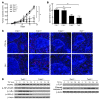TNF signaling drives myeloid-derived suppressor cell accumulation
- PMID: 23064360
- PMCID: PMC3484453
- DOI: 10.1172/JCI64115
TNF signaling drives myeloid-derived suppressor cell accumulation
Abstract
TNF, an inflammatory cytokine that is enriched in the tumor microenvironment, promotes tumor growth and subverts innate immune responses to cancer cells. We previously reported that tumors implanted in TNF receptor-deficient (Tnfr-/-) mice are spontaneously rejected; however, the molecular mechanisms underlying this rejection are unclear. Here we report that TNF signaling drives the peripheral accumulation of myeloid-derived suppressor cells (MDSCs). MDSCs expand extensively during inflammation and tumor progression in mice and humans and can enhance tumor growth by repressing T cell-mediated antitumor responses. Peripheral accumulation of MDSCs was drastically impaired in Tnfr-/- mice. Signaling of TNFR-2, but not TNFR-1, promoted MDSC survival through upregulation of cellular FLICE-inhibitory protein (c-FLIP) and inhibition of caspase-8 activity. Loss of TNFRs impaired the induction of MDSCs from bone marrow cells, but this could be reversed by treatment with caspase inhibitors. These results demonstrate that TNFR-2 signaling promotes MDSC survival and accumulation and helps tumor cells evade the immune system.
Figures







References
Publication types
MeSH terms
Substances
LinkOut - more resources
Full Text Sources
Other Literature Sources
Molecular Biology Databases

